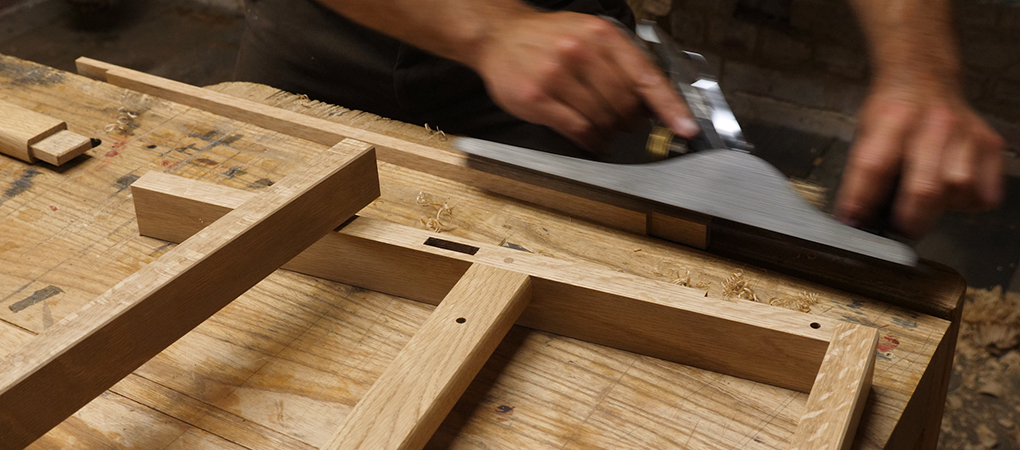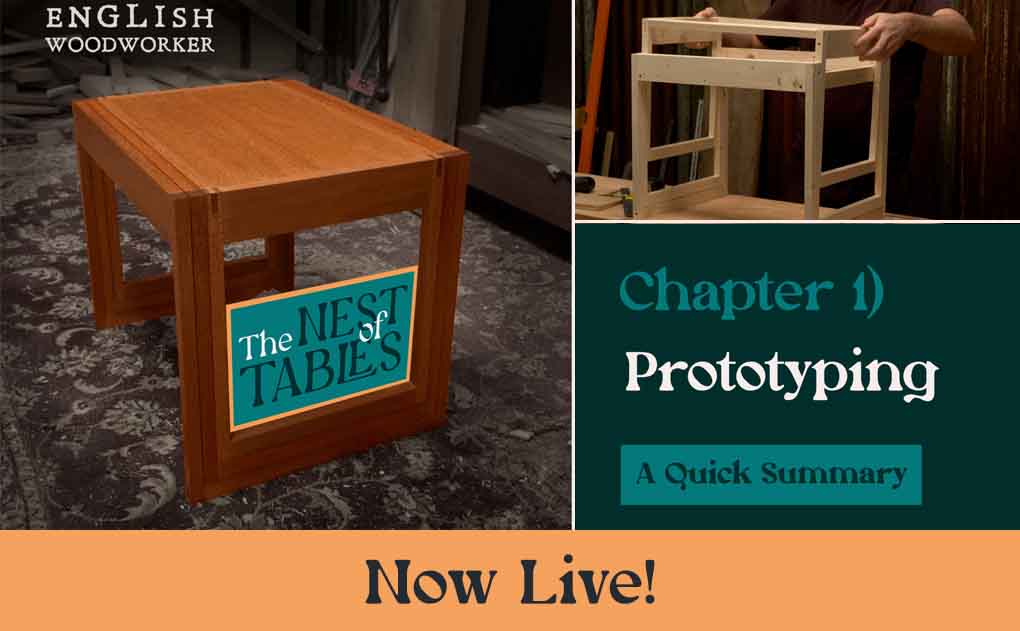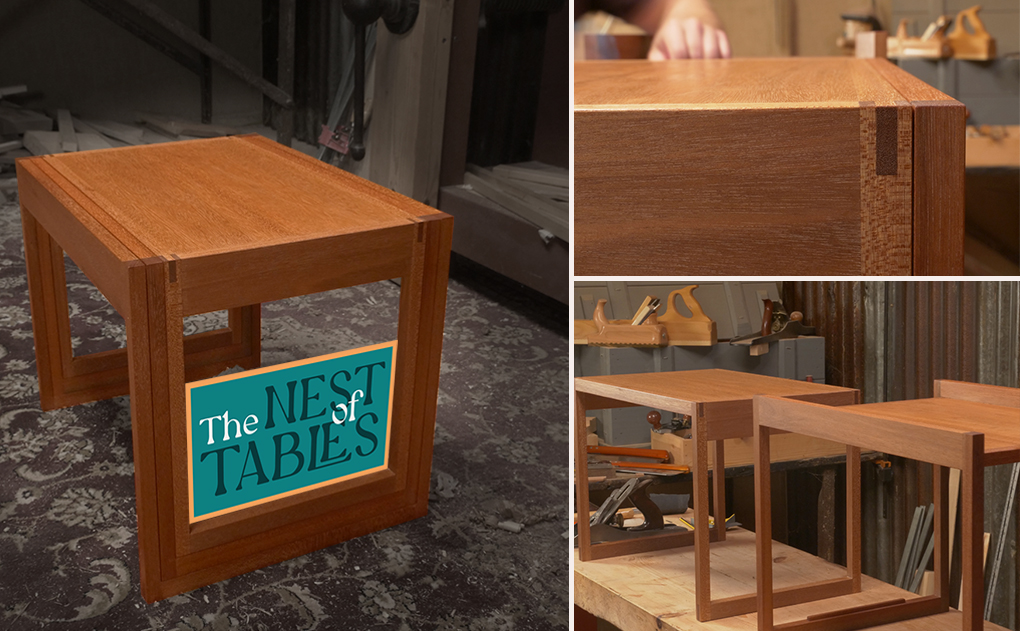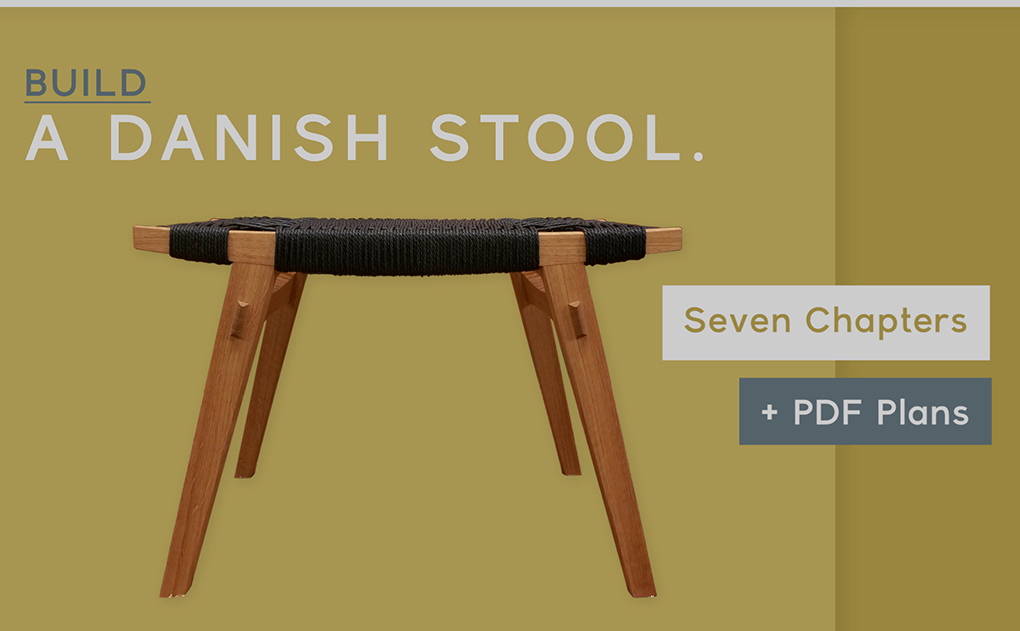When people meet me they see the unkempt facial hair and questionable mop on the back of my head and they can weigh me up pretty well.
Then I start to speak and it’s confirmed – this is definitely a pretty rough chap.
And I’m not one to try and mystify or tart it up, I’ll call a spade a spade. What you see really is what you get. I do have a lot of the same t-shirts for example.
 But this isn’t always the best thing for when it comes to selling ourselves.
But this isn’t always the best thing for when it comes to selling ourselves.
I tell you how I like to work wood fast with some naff hand tools and you’re hearing “Rough + Rough = Rough”.
It’s not what you want to hear if you’re looking to learn how to build something worth showing off.
So when we read this comment on the Chair Build the other day we both chuckled. Then thought… perfect!
Your banged up workbench/shop, your shitty old tools would all lead to someone thinking your work is going to be a bit low grade but it’s incredibly accurate.
I watch ALOT of woodworking videos and your style of teaching and production is first class – I really hope you continue to turn these out…. – Jaime C

So it’s a bit of a contradiction, but having an efficient approach to woodworking and using cheap old hand tools has never been an excuse for turning out rough furniture.
Quite the opposite, I feel a craftsman should always take pride in his work, right down to perfecting the point on his pencil or brewing his tea.
Aim for perfection because your work should be strong and it should be beautiful. It’s strength will endure real use and it’s beauty demands respect which means it will be looked after.

Hair grows on my face.
By some wisdom it might be considered rough to leave it there but I’ve never really heard of a good reason why this is the case.
There are numerous short cuts that I’ll take with my woodworking to make sure that the job can be done productively. And there are numerous reasons that I don’t use posh tools (some practical, some just sentimental).
But If a craftsman analyses my furniture and spots the short cuts I hope to please them. Instead of rough stubble they should see purpose.
But if a customer views my furniture they should always see perfection.
In my world Rough + Rough = Fine.
Thanks Jaime, you really made my day.

As you can see we’re coming to the end of our chair build.
You can find all of the updated details here if you’d like to have a go at building your own chair.
Or if you’re looking to learn woodworking and fancy a different project, you can have a browse here.

![Simple Work Holding For Ploughing Grooves [Without a Tail Vice]](https://www.theenglishwoodworker.com/wp-content/uploads/2022/07/workholding-without-tail-vice-copy.jpg)



I worked for 40 years in the business world where how you looked meant everything. I dressed as I wished, sported a beard for 25 years and spoke as I wished. When I talked to you, I was straight with you and if I shook your hand on an agreement you could make damned sure I’d keep my end up.
I look at Richard and see a tough life but a life that shaped him. When I hear Richard, I hear many years of experience but done HIS way. When I watch Richard work, I see a craftsman doing his thing. I enjoy watching Richard’s videos because he works simply and directly. He is a craftsman that we could use many more of in this world of machines and cut rate products.
Well said. I couldn’t have put it more eloquently if I tried.
Truly inspirational. In a past life, I worked as a professional suit as a member of the design team (the suited knobs who never got their hands dirty) and I must say, even the most expensive luxurious buildings in the world are built and finished (in the main) entirely by folks who tend to have their hairy arse cracks on display a lot – have a vocabulary which would be limited to a mere handful of words if all the swear words were discounted and whose manners were akin to rutting wild animals at best – yet – and yet – from all this shite looking bollocks pops a diamond. Every single building in the world was built and fitted out by them. The main man himself, Jesus, was a hairy arsed carpenter – and he was God – and he could have done anything – but chose to make gorgeous things instead. Everyone bangs on about a bloody cup, the holy grail – but I want to see inside his toolbox – and the underside of that table at the last supper – I bet his joints were shit hot.
You, sir, have a firm grasp of reality. Don’t let it go.
I really appreciate your approach to this craft. I feel that we are getting a straight from the shoulder approach that has helped me understand what woodworking is about. You are not in an office where everyone ‘dolls up’ to impress each other. Most of these people couldn’t do anything useful if their life depended on it. I speak from experience, I worked for 40 years in that type of an environment. I really appreciate a person that you can take for face value, and not worry about getting stabbed in the back.
Keep up the good work.
I work in the lowest of the low professions: Compliance in Financial Services!!! Spreadsheets, PowerPoint slides and endless meetings. I’d give my right arm to do what you do and I tell you watching your videos and then dabbling with wood in my shed is one of the few things that keep me sane. Keep up the good work: I for one am enormously grateful for the time you take to share your passion.
I use to work in a factory when I was younger, Now I work in IT, I am really tired the office kiss butt, backstab anyone to get ahead, while smiling at you and making you think I like you tripe. I hate the dress code, like that make a good worker. Some the work work ethics I have seen in people come from well dressed and well spoken people.
I really like your working mans approach. I really miss working around people like you. Some days I really wonder why I waned this and how I got here.
Cruddy old tools are not quite so cruddy if they are clean and razor sharp. They become completely cruddless when they are manipulated with infinite accuracy by a pair of strong sensitive practiced hands. And if all that can sometimes produce an item of utility or even beauty, you will require a well wired human brain…… with, or without a suit..
At the end of the day what is produced cannot be hidden like so many occupations I have seen . The output from work is a physical real object. If rubbish is produced then it shows- either immediately visually which can generally be seen by most or by time and tide when it fails prematurely. The methodology behind the usage of the tools to achieve this is not dependent on the tools even though I have come across some that should not be made because they waste good resources . You covered this with your statement about the best cup of tea or sharpening your pencil right. I like nice tools, I run a range from new to rehabbed to pretty near original condition . If I don’t apply myself and pick up my faults then the end result is below par and on a particularly bad day a bin job. Professionalism comes in recognising and doing something about it so you don’t repeat it, or do it in the first place. Keep up the great work Richard, I’m learning all the time.
This post reaches the heart and soul of our craft. It puts into words that inexplicable force that drives us to keep learning and improving.
Richard-
You underestimate yourself. You are a true leader. We are fortunate to have you to follow.
King of the North!
I had a photography teacher expresss the same idea. He said a good photographer could take great photos with a crummy old throw away box camera. Understand the basics and use your skills. Thanks for your insight.
Kevin
Great post. Many of us who shower before going to work instead of after feel a great need to get our hands dirty after hours and on weekends. It isn’t just silly timewasting either–there is something honest in making things with your hands, an honesty some of us lack in our day jobs. So even though it is ‘just’ a hobby for us, we want, badly, to learn to do it well. Your techniques and explanations feel like the right kind of learning, a straightforward kind that helps us better fill that gap in our lives. Thanks, and please keep it all coming.
Couldn’t’t have put it better, Tim
Hi Richard,
I just watched this old video of a guy building a boat with hand tools. Thought you might like seeing him work.
https://www.youtube.com/watch?v=mCeeJLcrwQE
Fascinating film. Loved paring the peg sides and hammering in the wedge: perfect fit. Those wedged clamps are brilliant. The use of a knife for chamfering and shaping. The axe paring down , all marvellous.
Thank you for posting this
Thanks for posting that video. Some of the planning shown is really interesting, like felling the tree with enough roots for the crooking and continuous fiber. The “self wedged” pegs are really interesting too.
Very well said, Richard. I believe that we should always seek perfection, because if there is no perfection, at least we will get as close as possible. And the work will be great.
Hi Richard:
I will be eighty in February. I have messed with wood since the mid to late 1940’s. I loved carving boats out of sticks of firewood; if you can call that working with wood. I first encountered a woodwork shop at school, in 1949. I took to it like the proverbial duck to water. Why I never became an apprentice I don’t know. Although many of my contemporaries were unemployed some twenty years later. So maybe I did the right thing by joining the RN at fifteen and a half years old. I have met a multitude of woodworkers, especially the shipwrights in the RN, who taught me much. Those guys could make wood and their tools talk. After demob, I worked in the wood trade as a joiner, but only for a couple of years. I decided I wanted to do this stuff as a hobby, and have done so ever since. I have one or two other ‘heroes.’ of woodwork, but in particular I like the way you present yourself; I like the way you talk about your tools, and I like your no-nonsense methods; which get the job done, efficiently, and even if some of them are not necessarily the ‘accepted’ modus operandi. I met you; at a UKW ‘bash’ (In Salisbury if I remember correctly.) I’ve been a follower since I was considering buying a workbench some years ago. (I didn’t buy one of course!) I haven’t always worked totally by hand, but now I am losing my natural strength, I am going, to work by hand as much as possible. I will be using PAR timber wherever possible. The only machine I’ll be using will be a chop saw, because replacement knees don’t allow me to use a sawhorse. So thanks for the entertainment, education, and inspiration you give me to carry on regardless of my offspring having reservations!
Cheers
John in Brum.
I heard this the other day from a man I could not respect any more in this lifetime – “It’s not what we make …… but, how we make it!” I had never heard this thought put this way before, but that is the approach I have been aiming at all these years. Oh, and I get tired of gobshites judging a book by it’s cover, when I was dealing with the public daily I was more than likely too clean cut and now that I don’t have that job any more I’ve let everything grow a bit more scraggly. You’d have thought I committed mortal sin, with all the wild looking people I see daily I am the one to be judged – yeah right?! Keep up the good work you are doing fine, as for the “class” based system, well …..
Hi Richard!
I am interested in trying to build my own marking gauge. Do you have a post about that or a video or any suggestions? I saw one where you explain how to use, but i would like to build one. Thanks for all your work.